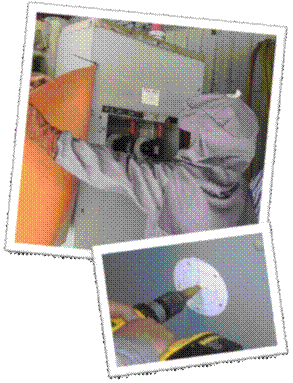Martin Robinson
President
IRISS, Inc.
4914 Lena Road, Suite 105Bradenton, FL 34211Ph: 941-907-9128www.iriss.com
Abstract
Infrared windows provide a cost-effective and safer alternative to traditional inspections. This paper will discuss how this mill realized a return on investment very quickly while benefiting from the other intangibles of infrared windows. Namely: The ability to inspect the previously un-inspectable equipment; the ability to inspect critical applications more frequently; the ability to more aggressively monitor any applications which are suspected to be running to failure; increase in safety for personnel; decrease in risk to plant assets and operations due to non-invasive nature of inspection – safeguarding profitability and freeing up critical personnel who can be utilized for other valuable jobs in the plant rather than removing and reinstalling panels.
Overview
A paper mill in South Carolina had a very successful infrared inspection program that management wanted to expand. However, the requirements of NFPA 70E were causing them to re-think their strategy since inspections of energized equipment was becoming more restrictive, more time consuming and more costly. Furthermore, 8% of the mill’s applications had never been surveyed due to switched interlocks (which automatically deenergize the equipment upon opening, thereby preventing access to energized components), or due to incident energy calculations in excess of 100 cal/cm2 on certain equipment (which exceeds personal protective equipment [PPE] ratings, and would place personnel in extreme danger and open the company to OSHA fines).
In search of alternative methods for conducting safer, standards-compliant inspections, the corporate Reliability Engineer investigated how infrared inspection windows (commonly referred to as IR windows, viewports, or sight glasses) might be utilized. It was determined that:
- Use of Infrared Windows for routine inspections of healthy equipment did not require the elevated levels of PPE required in 70E, since as stated in 70E 100: “Under normal operating conditions, enclosed energized equipment that has been properly installed and maintained is not likely to pose an arc flash hazard.” In NFPA terms, an IR window maintains an “enclosed” state for the switchgear, MCC, transformer, etc., and maintains energized components and circuit parts in a “guarded” condition. Therefore, the hazard/risk category would be equal to that of reading a panel meter, using a visual inspection pane for lockout/tagout confirmations, or walking past enclosed, energized equipment.
- Use of IR windows or “sightglasses” would eliminate the need for a supporting cast of electricians to remove and reinstall panel covers. Those critical personnel would then be available to perform other tasks, which were often being outsourced.
- Use of infrared windows would provide an efficient method to perform inspections. This would make more frequent inspections feasible for critical or suspect applications to ensure plant uptime.
- Use of IR windows would provide non-intrusive access to electrical applications; therefore, surveys could be conducted without elevating the risk to plant assets and processes, meaning that inspections could be conducted during peak hours for the best diagnostic data.
- Use of IR windows and closed panel inspection would eliminate high-risk tasks during inspections and thereby increase safety for thermographers.
The focus of the mill’s initiative was to facilitate inspection of the primary switchgear in their electrical distribution system which feeds one paper machine and several smaller operations within the plant. An impending ten-day shutdown increased the sense of urgency since all windows could be fitted for one machine during that period.
IRISS was commissioned by the paper mill to conduct a pre-site inspection to ascertain the optimal position and quantity of windows which would give thermographers thorough visibility of desired targets. The conclusions from the initial inspection are noted in Table 1.
| 13.8 kV Primary Switch | 15 |
| Secondary Switchgear | 22 |
| Transformers (13.8 kV) | 27 |
| MCC’s | 2 |
| Miscellaneous Switchgear | 2 |
| Generators | 2 |
| Total Assemblies | 70 |
| Inspection Compartments | 147 |
| IR Windows | 197 |
Table 1
The customer ordered 200 units of assorted VPFR-75 (3 inch diameter) and VPFR-100 (4 inch diameter) Infrared Inspection Windows to complete the installation. 197 windows were later installed.
Investment
197 VPFR infrared inspection windows totaled $42,050. IRISS was also retained to supply an installation team to perform the installation of the IR windows.
Installation costs cited in Table 2 were calculated using the following assumptions:
- Two-man installation team at $625 each per day (total cost $1,300 per day) x 10 Days = $13,000.
- $30 per window installation charge x 197 windows = $5,910.
| Infrared Windows (197 units assorted 3 & 4 inch diameter) | $42,050 |
| Install Costs for 197 IR Windows | $18,910 |
| Total | $60,960 |
Table 2
The Installation
 Installation of the infrared inspection panes was conducted during three nights and three days during the ten-day shutdown. Some installations were completed on live gear using additional safety measures; however, the vast majority were conducted on deenergized equipment in what NFPA terms an “electrically safe work condition”.
Installation of the infrared inspection panes was conducted during three nights and three days during the ten-day shutdown. Some installations were completed on live gear using additional safety measures; however, the vast majority were conducted on deenergized equipment in what NFPA terms an “electrically safe work condition”.
Although our plan allowed for twelve-hour shifts, installers were quickly and safely moving at a rate of approximately six window installations per hour, and were finishing the plant on the night shifts within six hours. Installations during normal business hours allowed much more flexibility; therefore, all “live works” were completed during these periods. When the clients’ electricians assisted with the installations, the installation rates were also faster than originally planned (7 to 8 windows per hour). All window installations were completed well within the allotted timelines.
Inspection Cost Analysis
Prior to the installation of the IR windows, all infrared inspections were completed on open, energized gear. Therefore, PPE, live works procedures, risk assessments, permits, etc. were required for all inspections, and as noted earlier, several applications had never been surveyed due to safety restrictions.
The paper mill had previously invested in its own infrared camera and an on-staff thermographer. The thermographer was trained and “qualified” to assist in opening panels on energized gear. Therefore, some efficiencies were already in place when compared to a typical crew of a single thermographer plus two electricians. Consequently, the man-hour calculations for the “traditional inspection” are actually conservative.
Table 3 details the man-hour costs for infrared surveys using in-house staff without infrared windows or viewports. The following assumptions are made:
- Total man-hours per inspection of “inspectable” equipment: 331 hours (23 days)
- Staff electrician internal charge-out rate: $125.00 per hour
- Staff thermographer assists with panel removal, etc. (two-man task)
- PPE suit-ups twice per day, per man (30 minutes per man per suit-up)
- One man-hour per compartment panel for safe removal, etc. (times two for two-man team)
- 147 individual panels to inspect (per Table 1)
| Traditional Inspection Time (Hrs. x 2 per team) |
294 | $36,750 |
| PPE Suit-up Time (0.5 hr. x 2 per day x 2 men) |
37 | $4,625 |
| Total | $41,375 |
Table 3
After the infrared windows were installed and there was no requirement to remove panels or wear increased levels of PPE, the task became a one-man job. The increased efficiency and economies of motion and man-power which infrared windows provided, significantly decreased the time required to complete a survey to just two eight-hour days for a total of just 16 man hours. The costs associated with an infrared survey using the IR windows are detailed in Table 4.
| Inspection Time | 16 | $2,000 |
| PPE Suit-up Time | 0 | $ 0 |
| Total | $2,000 |
Table 4
Compared to the costs of traditional inspections (Table 3), the paper mill now saves $39,375 per inspection cycle because of the efficiencies they gained through the use of infrared windows.
ROI
Table 5 combines the data from the previous tables to illustrate the ROI for the paper mill based on the initial investment in the IR windows, the investment in installation and the costs to perform surveys using the windows, compared with the mill’s traditional costs of using their in-house team while not using any windows.
Using infrared windows is shown in this example to pay dividends as early as midway into the second inspection cycle, yielding almost $18,000 in savings which can be put back into the budget by the end of the second cycle. In just five inspection cycles, the mill shows a savings of over $135,000.
| 197 Infrared Windows | $42,050 |
— |
|
| Installation of Windows | $18,910 |
— |
|
| Cost for 1st Inspection Cycle | $ 2,000 | $41,375 | |
| Total for 1st Cycle | $62,960 | $ 41,375 | <$ 21,585> |
| Cost for 2nd Inspection Cycle | $ 2,000 | $ 41,375 | |
Total for 2 Cycles |
$64,960 | $ 82,750 | $ 17,790 |
| Cost for 3rd Inspection Cycle | $ 2,000 | $ 41,375 | |
| Total for 3 Cycles | $66,960 | $ 124,125 | $ 57,165 |
| Cost for 4th Inspection Cycle | $ 2,000 | $ 41,375 | |
| Total for 4 Cycles | $68,960 | $165,500 | $ 96,540 |
| Cost for 5th Inspection Cycle | $ 2,000 | $ 41,375 | |
| Total for 5 Cycles | $70,960 | $206,875 | $135,915 |
Table 5
Moreover, because inspections can be completed with greater ease and without increased risk to plant, personnel and processes, the frequency of inspection cycles has been increased to quarterly, reflecting best-practices recommendations which were previously not feasible and thought to be unattainable. The new inspection cycle brings ROI to the plant in just one quarter, while reducing the risk of catastrophic failure among the plant’s critical power distribution systems, which will in turn minimize production losses due to equipment failure.
Future Installations
Additional window installations have been planned and scheduled to occur during the facility’s next shutdown. Because the customer’s in-house electricians were trained to install infrared windows, the installation costs for future installations will be a fraction of the cost of the original installation, saving even more money and accelerating the ROI for additional windows.
Conclusion
This mill realized a return on investment very quickly while benefiting from the other intangibles of infrared windows. Namely:
- The ability to inspect previously un-inspectable equipment
- The ability to inspect critical applications more frequently
- The ability to more aggressively monitor any applications which are suspected to be running to failure
- Increase in safety for personnel
- Decrease in risk to plant assets and operations due to non-invasive nature of inspection – safeguarding profitability
- Freeing up critical personnel who can be utilized for other valuable jobs in the plant rather than removing and reinstalling panels
A portion of the financial savings were used to continue to build and strengthen the PdM Program through the purchase of a second IR camera for the maintenance electricians. This also underscored the mill’s commitment to practical use of technology to ensure uptime while enhancing the safety of its workers.
Infrared windows provide a cost-effective and safer alternative to traditional inspections. To learn more, visit www.iriss.com where you will find more case studies and white papers.
Visit out Sponsors:
Electrophysics






